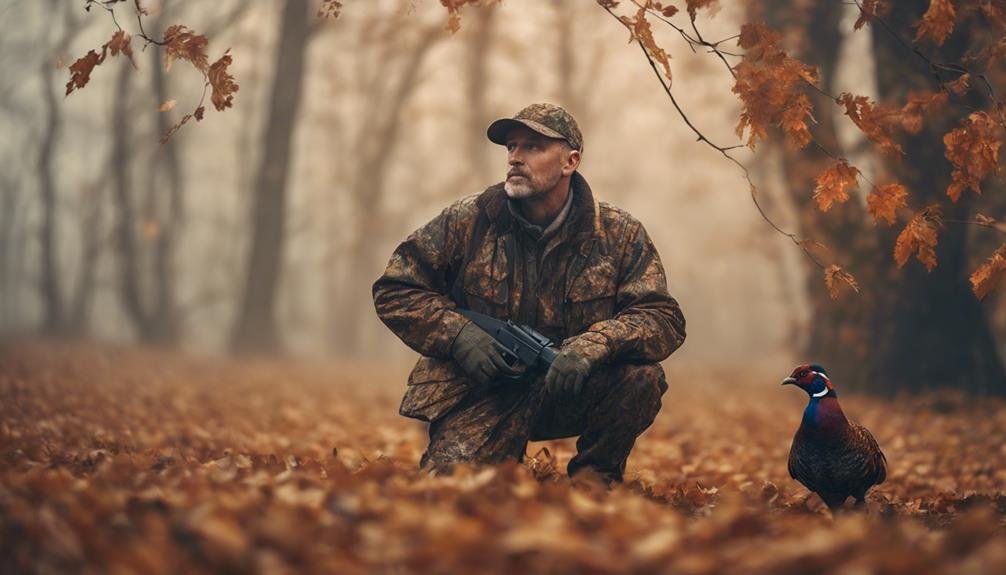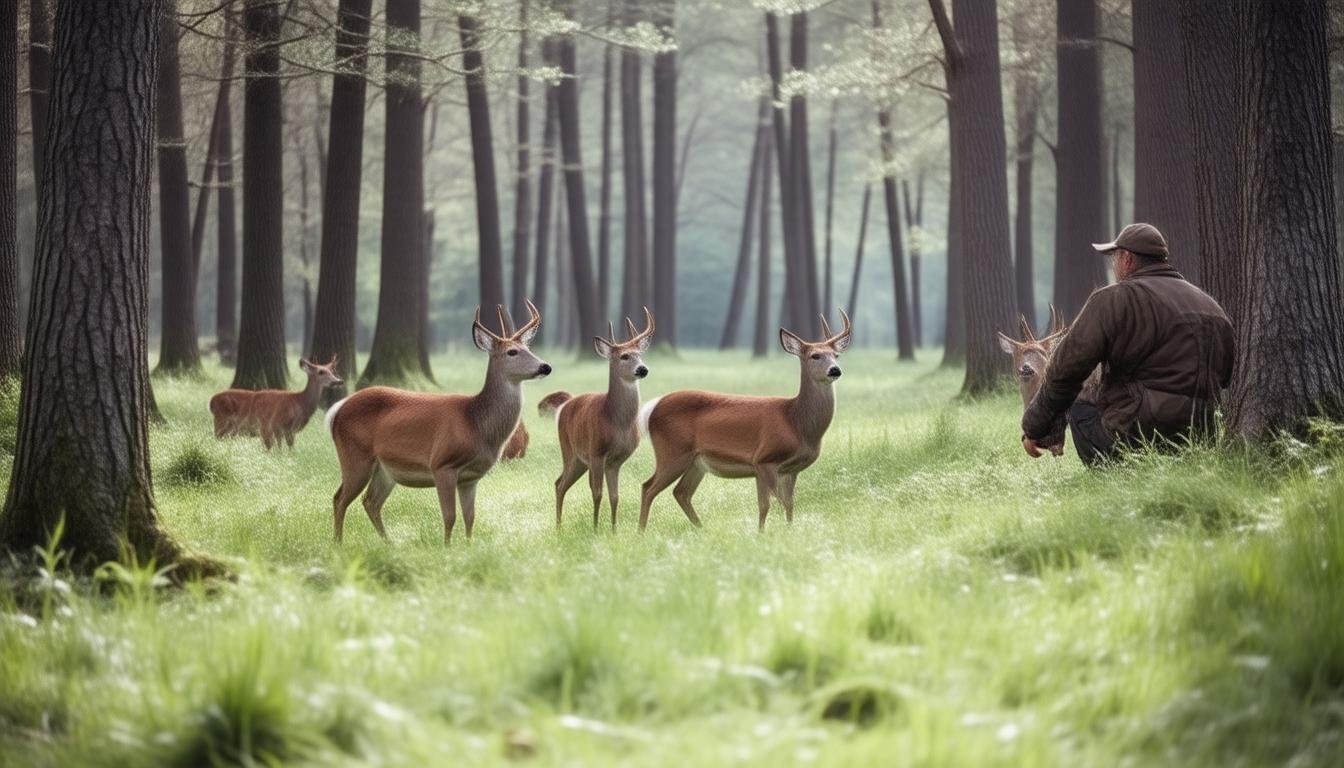Effective pheasant hunting demands a subtle blend of art and science. Mastering stealthy approaches, understanding bird patterns, and recognizing preferred habitats are essential to success. A well-executed strategy can mean the difference between a fruitful hunt and a frustrating one. Adaptability is key, as field dynamics and bird behavior change with the seasons. By fine-tuning your approach and staying attuned to the environment, you'll increase your chances of bagging that elusive bird. As we peel back the layers of pheasant hunting secrets, you'll discover the nuances that separate the experts from the novices – and uncover the hidden patterns that lead to a successful hunt.
Key Takeaways
- Mastering stealthy approaches and understanding bird patterns are crucial for a successful pheasant hunt, increasing chances of encountering birds.
- Combining field navigation skills with knowledge of bird patterns develops a winning strategy for upland bird hunting.
- Effective communication among hunters ensures everyone is on the same page, maintaining a smooth operation and increasing shot opportunities.
- Understanding pheasant behavior and habitat analysis reveals ideal hunting spots, increasing the chances of a successful hunt.
- Adapting to changing weather conditions, terrain, and bird behavior mid-hunt is key to staying on top of the game.
Mastering Stealthy Approaches
As you pull into the parking area, the crunch of gravel beneath your tires serves as a stark reminder that a stealthy approach is essential, and the distance between your vehicle and the hunting area is the first line of defense against spooking your quarry. Early Risers, those who arrive at the break of dawn, know that a quiet, deliberate approach sets the tone for a successful hunt. Fieldcraft skills, such as moving quietly and staying concealed, are vital in getting close to your prey. A well-executed approach can mean the difference between a fruitful hunt and a disappointing one. By mastering the art of stealth, you'll increase your chances of bagging those elusive birds. It's time to refine your skills and become a master of the silent approach.
Avoiding Common Hunting Mistakes
While a stealthy approach sets the stage for a successful hunt, it's equally important to recognize and avoid common mistakes that can quickly turn a promising outing into a frustrating experience. A thorough game plan, prioritizing safety first, and adopting a hunter mindset are vital in minimizing mistakes. Before heading out, a pre-hunt checklist can help verify you're fully prepared. Conducting a mistake analysis after the hunt can also help identify areas for improvement. Common mistakes to avoid include underestimating the intelligence of pressured pheasants, making loud noises, and failing to adapt to changing weather and bird behavior. By being aware of these potential pitfalls, you can refine your hunting strategy and increase your chances of success. A well-planned and executed hunt requires attention to detail and a willingness to learn from mistakes.
Upland Bird Hunting Strategies
In the domain of upland bird hunting, a deep understanding of the bird's behavior and habitat is essential for a successful hunt, as the subtle nuances of their habits can make all the difference between a thrilling flush and a disappointing blank. Mastering field navigation is imperative, as it allows hunters to navigate complex terrain and pinpoint areas of high bird activity. Understanding bird patterns is also indispensable, as it enables hunters to anticipate and adapt to the birds' behavior. By recognizing preferred habitats, such as dense cover and food sources, hunters can increase their chances of encountering birds. By combining field navigation skills with knowledge of bird patterns, hunters can develop a winning strategy for a successful upland bird hunt.
Late-Season Pheasant Hunting
Late-season pheasant hunting presents a unique set of challenges and opportunities, with birds that have been educated by months of hunting pressure and harsh winter weather, forcing hunters to adapt their tactics and strategies to be successful. To thrive in this environment, hunters must employ late-season strategies that take into account the changing field dynamics. Here are three key considerations:
- Speed and stealth: Move quickly and quietly to keep up with birds that have become wary of hunters.
- Adapt to weather: Changing weather conditions can greatly impact bird behavior, so be prepared to adjust your strategy accordingly.
- Field dynamics: Understanding how birds move and interact within the field is essential for a successful hunt.
Big Game Hunting Challenges
Elk hunting, in particular, presents a unique set of challenges that demand a deep understanding of elk behavior, habitat, and adaptability. Traversing the wilderness terrain, identifying prime elk habitat, and adapting to changing weather conditions are just a few obstacles that big game hunters face. Elk habitat, characterized by dense forests, steep terrain, and limited access, requires a hunter to be physically fit, mentally tough, and strategically sound. Wilderness navigation skills are essential to successfully tracking and pursuing elk. A deep understanding of elk behavior, including their migration patterns, feeding habits, and social structures, is crucial to increase the chances of a successful hunt. By mastering these skills, big game hunters can overcome the challenges and reap the rewards of a thrilling elk hunt.
Pressured Bird Tactics
When hunting pressured birds, acknowledging that these wary creatures have been pushed to the limits of their tolerance, forcing them to adapt and become increasingly cunning, makes every hunting strategy and tactic count. Understanding bird psychology is essential in this scenario, as pressured birds require a more nuanced approach.
To increase shot opportunities, consider the following tactics:
- Aggressive flushing: Apply constant pressure to pressured birds, forcing them to flush sooner rather than later.
- Unconventional approaches: Try hunting the middle portions of a field first, or using blockers and drivers to push birds towards your position.
- Adaptability: Be prepared to adjust your strategy based on changing weather and bird behavior.
Hunting Wild Game Essentials
Among the most critical aspects of hunting wild game is a deep respect for nature and the animals being hunted, which serves as the foundation for a successful and responsible hunting experience. This respect is built on a strong foundation of hunting ethics, emphasizing fair chase, conservation, and a commitment to harvesting game in a manner that promotes sustainability. When hunting wild game, understanding the delicate balance between humans and the natural world is crucial. By adopting a respectful and mindful approach, hunters can guarantee that their actions have a positive impact on the environment and the animals they pursue. By doing so, we can preserve the integrity of wild game hunting for future generations.
Effective Hunting Resources
Numerous online resources, articles, and hunting communities provide valuable insights and tips for hunters, offering a wealth of information to help refine hunting strategies and tactics. These resources can be a treasure trove for hunters looking to improve their skills and increase their chances of success.
Here are three effective hunting resources that every hunter should utilize:
- Hunting Apps: Apps like OnX Maps and HuntStand provide valuable information on land ownership, property boundaries, and habitat conditions, helping hunters make informed decisions in the field.
- Online Forums: Online forums like Reddit's r/hunting and hunting-specific Facebook groups offer a platform for hunters to share their experiences, ask questions, and learn from others.
- Hunting Blogs: Blogs like Pheasant Blog and Upland Journal provide in-depth articles and guides on hunting strategies, gear reviews, and species-specific tips.
Understanding Bird Behavior
As hunters, we've all experienced the thrill of flushing a covey of pheasants from a dense thicket, but understanding the intricacies of bird behavior is what sets the skilled hunters apart from the rest, allowing them to anticipate and capitalize on these exciting moments. By understanding bird migration patterns, we can pinpoint areas of high bird density and adjust our hunting strategies accordingly. Habitat analysis is also vital, as it reveals the types of cover and food sources that attract pheasants. By studying bird behavior, we can identify areas with ideal habitat conditions, increasing our chances of a successful hunt. By combining bird migration patterns with habitat analysis, hunters can make informed decisions about where and when to hunt, ultimately leading to a more productive and enjoyable hunting experience.
Adapting to Changing Conditions
Fluctuations in weather, bird behavior, and hunting conditions require hunters to adapt their strategies on the fly, making flexibility a vital component of a successful pheasant hunt. As conditions change, hunters must be prepared to adjust their tactics to stay on top of the game.
Here are three key factors to consider when adapting to changing conditions:
- Weather Flexibility: Be prepared to adjust your hunting schedule according to weather forecasts, as pheasants may alter their behavior in response to changing weather patterns.
- Condition Awareness: Stay attuned to changes in the terrain, vegetation, and bird behavior, as these can impact the success of your hunt.
- Tactical Adaptability: Be willing to adjust your hunting strategy mid-hunt, as pheasants may require a different approach depending on the conditions.
Coordinating With Fellow Hunters
Coordinating with fellow hunters is essential to a successful pheasant hunt, as it allows hunters to cover more ground, increase shot opportunities, and most importantly, work together to drive birds towards waiting hunters. Effective Hunting Comms are key to a well-executed hunt, ensuring everyone is on the same page. Establishing clear roles and responsibilities within the team helps to maintain a smooth operation. Team Dynamics play a significant role in pheasant hunting, as a cohesive unit can cover more ground and adapt to changing conditions. By working together, hunters can set up effective drives, blockades, and ambushes, ultimately increasing their chances of success. By maintaining open communication and flexibility, hunters can capitalize on opportunities and make the most of their time in the field.
Frequently Asked Questions
What Is the Best Camouflage Pattern for Pheasant Hunting?
When it comes to pheasant hunting, choosing the right camouflage pattern is essential. Camouflage evolution has led to a variety of pattern preferences, but for upland game birds, a natural, earth-toned pattern with subtle texture is often most effective.
Can Pheasants See Colors Like Orange and Yellow?
"Research suggests pheasants possess limited color vision, with reduced visual acuity compared to humans. While they can detect movement and contrast, their color perception is thought to be limited to blues and yellows, with orange and yellow likely appearing as a dull brown or beige."
How Often Should I Rotate My Hunting Spots to Avoid Pattern Recognition?
"Rotate hunting spots every 7-10 days to avoid pattern recognition, as pheasants adapt quickly to hunting pressure. Habitat diversity is key; mix up fields, woods, and wetlands to keep birds guessing and patterns unclear."
What Is the Most Effective Pheasant Call to Use During Late-Season Hunts?
During late-season hunts, the most effective pheasant call employs varied sound techniques, incorporating soft, raspy, and high-pitched calls to mimic hen and rooster vocalizations, increasing the likelihood of enticing wary birds into range.
Can I Use Bird Dogs for Hunting Late-Season Pheasants?
Picture a choreographed dance: dog and hunter moving in harmony, traversing treacherous field conditions. For late-season pheasants, a well-trained bird dog is invaluable, requiring precise training to traverse dense cover and pinpoint birds.
Conclusion
In the pursuit of pheasant hunting excellence, 'knowledge is power' rings particularly true. By mastering stealthy approaches, avoiding common mistakes, and adapting to changing conditions, hunters can increase their chances of success. Effective hunting strategies, a deep understanding of bird behavior, and coordination with fellow hunters are essential in this challenging yet rewarding pursuit. As the hunting season unfolds, a profound respect for the natural environment and a commitment to continuous learning will ultimately separate the skilled hunters from the novices.









